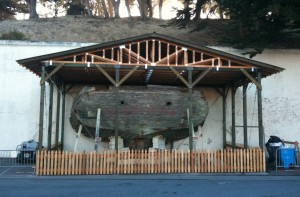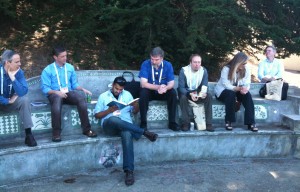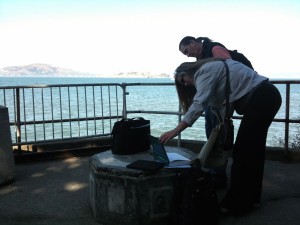I’m seeing a lot more familiar faces at Agile Open Northern California 2010 than I had been in previous years: before, I’d always been surprised at the low percentage of repeats, but this year I’m seeing people I know everywhere I look. So: glad others also find this valuable enough to keep coming back! (Or maybe they, like I, are suckers for the setting, by far my favorite conference venue.)
10:30am: Why Agile?; User Documentation and Agile
I stayed for about half of the first one session listed here. We spent most of that time talking about how people problems are important but hard. Which is true; it’s something I struggled with at Kealia/Sun, it’s something I’m struggling with at Playdom.
After that, I wandered around a bit, ultimately ending up in a doc writing session. Interesting questions there, e.g. If you implement a single button (of multiple planned ones) on a page, when do you document it? I have a first instinct for what the answer is, but I suspect the question could shed some new light on problems with feature flow. And if tech writers are a shared resource (which seems fairly common), that throws another wrench into the works.
(Though of course I have an answer to that from a technical lens: avoid specialization when possible. Is it possible there? E.g. How well do tech writer and QA skill sets overlap?)
12:00pm: So You Have Slow Tests, Now What?
We started off taking a poll of what we meant by slow tests, and got a huge range of responses, from 5 minutes (or even 25 seconds) to multiple hours (or even more than a day, but they parallelized that one to only be a few clock hours). Which would make me happier about the length that the tests in my current group take, were it not for the fact that we have so few! (In particular, no automated integration/end-to-end tests that the team maintains, though I’m actually working on improving that right now.)
I mainly went because our unit tests are way too slow: they almost all depend on doing database access, and while we try to avoid constantly setting that up, it’s still the case that running even one “unit” test can take a good 25 seconds, which is a real friction point for doing TDD. And the answer to that is pretty obvious: by hook or by crook, I need to mock out that. Which I’ve been putting off, but talking about it in public makes me confront the question of how hard it can be? And, when I think about it, my best guess is one day to get something in, plus or minus a factor of two; I can definitely find time to do that soon.
1:30pm: The Christopher Alexander Bench
After looking at the bench last year, I decided that I had to hold a session there unless it was pouring: its presence is too much of a coincidence to pass up, and the setting here is so gorgeous that I’ve always felt it was a shame that we never have sessions outside. So I scheduled one, with absolutely no plans for topics to discuss: if the setting inspires us to discuss something, that’s great, otherwise we’ll just look at Alcatraz and Angel Island for a bit and then wander off to other sessions.
And it was great! A dozen people showed up, Tom Looy began with an appreciation of Alexander’s notion that variation within a pattern leads to beauty, and we were off and running. For whatever reason, we talked a lot about planning meetings, starting with the benefits of physical cards over Jira tickets and ending up with a heated discussion about estimation; no idea why we ended up there, but people were actively participating, which is all I need to declare it a success.
We did touch on the bench occasionally, too: I passed around the book, and we were inspired by the paragraph at the beginning of the relevant section:
In the kind of dynamic process I have in mind, where each act that is taken, is related, in a structure-preserving way to the whole, and takes its place in a long time-line through a long sequence of events, each part, then, is carefully shaped and placed into the whole, making the whole more than it was before.
(Incidentally, I think the bench in its setting gives a great example of that last bit.) I talked a bit about those of the fifteen properties that I could remember; Lev Ayzner pointed out an example of Alternating Repetition that I’d missed, namely between more abstract and more naturalistic patterns on the front tiles.
Good stuff; I’ll probably do the same session again next year.
3:00pm: Kids / Education; Code Excellence; nap
I seem to be unable to attend a conference without napping through one session per day; this was today’s choice.
4:30pm: Key Unlearnings for Agile
Very good session, about bits of the pre-agile mindset that we not only needed to unlearn in the agile transition, but still need to unlearn! E.g. that I have to have all the answers, or an us versus them mentality between different groups (workers and managers, developers and product people, developers and testers). We generated lots and lots of examples, which almost all rang true to me; I recommend going to the notes on the wiki and the mindmap.
Post Revisions:
This post has not been revised since publication.






 Posts
Posts
Nice write-up! Thanks for sharing:-)
Cheers
Olaf
10/11/2010 @ 10:48 pm
[…] of the things I got out of Agile Open California this year was a decision that I should work harder at removing database access from the unit tests […]
10/25/2010 @ 9:37 pm